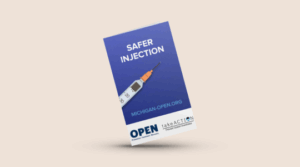Sep 25, 2025
Hello,
Happy Fall! As we begin to notice the fall colors appear, OPEN is excited to announce the soft launch of our newest service: The OPEN Warmline!
Through the Warmline, a person calling will be able to access same-day telehealth care for a buprenorphine prescription to treat opioid use disorder or be connected to a community provider who can best provide the type of care and support needed. The OPEN Warmline is staffed by a team of care navigators, a nurse care manager, peer recovery coach, and medical providers to provide same-day access to lifesaving treatment at the moment an individual is ready for change.
On September 29th, 2025, the Warmline will launch with an initial focus on serving clients releasing from the Michigan Department of Corrections before expanding statewide. Insurance will not be required to utilize this service.
We look forward to improving access to a life-saving medication for Michigan residents with an opioid use disorder.
Read the Press Release
Eliza Hutchinson, MD
OPEN On-Call Addiction Medicine Physician
CLINICIAN TO CLINICIAN CONSULT SERVICES
Have a question about managing patients with substance use disorder or complex pain? Request a virtual consultation with one of OPEN’s addiction medicine providers. Available Monday through Friday, 9AM to 5PM.

Submit a Consultation
OVERODSE RESCUE TRAINING EDUCATION PROGRAM

Knowing how to respond to an overdose is an important skill that could help you save a life. OPEN offers expert-led naloxone training to teach you everything you need to know to take action during a suspected overdose.
Request a Training Session
NEW RESOURCE: SAFER INJECTION POCKET GUIDE
Your health matters. Use this pocket guide to learn how to prevent infections, reduce risk of overdose, and stay safer while injecting.
Answer your questions:
- What are the different types of injections?
- What are the different parts of the syringe?
- Where are the safest spots to inject?

View Resource
UM HEALTH-WEST COMMUNITY HEALTH CENTER INSTALLS FREE NALOXONE DISPENSER TO HELP SAVE LIVES
University of Michigan Health-West has installed a new naloxone vending machine at its Community Clinic, located at 781 36th Street SE in Wyoming, thanks to a statewide initiative aimed at reducing preventable opioid overdose deaths. Provided by the Overdose Prevention Engagement Network (OPEN), the vending machine offers free access to naloxone, a medication that can rapidly reverse opioid overdoses, available without a prescription to patients, visitors and members of the public.
Read the Full Story
UPCOMING EVENTS
For prescribers, all webinar credits qualify for the DEA required SUD training. FREE CME, MCBAP and Social Work CE credits.
Youth Tobacco and Cannabis Use: What are they using, Why are we concerned, and What can we do
October 7, 2025
@12:00pm – 1:00pm
1.0 CE Credit
CME, MCBAP, SW
Presenter:
Bonnie Halpern-Felsher, Ph.D., FSAHM
Adolescents and young adults continue to use nicotine and THC, with newer forms of e-cigarettes and cannabis infiltrating the market. This presentation will provide detailed information on these substances, including rates of use, nicotine and THC levels, addiction, and other health effects, as well as marketing of these products. The presentation will also provide information on reasons for adolescent use of these products, including flavors, appeal, marketing, perceived reduced harm, stress, anxiety, depression, and misperceptions.
Buprenorphine in Primary Care: Key Considerations for Pain Management
October 14, 2025
@12:00pm – 1:00pm
1.0 CE Credit
CME, MCBAP, SW
Presenter:
Jane Chargot, MD
Join us for an engaging webinar that explores the use of buprenorphine in primary care pain management. This session will review the fundamentals of buprenorphine, evaluate the latest evidence supporting its use, and delve into the complex overlap between chronic pain and substance use disorders. Through real-life case examples, you’ll gain practical insights to enhance patient care.
Introduction to Treating Patients with Buprenorphine for Primary Care Providers
November 10, 2025
@8:00am – 12:00pm
4.0 CME Credits
Presenters:
Sheba Sethi, MD
Eliza Hutchinson, MD, FASM
Primary Care Providers (Physicians and Advanced Practice Professionals) who attend this MOUD training are eligible to receive a $250 incentive.
PUBLICATIONS THIS QUARTER
Access literature with OPEN’s publication portfolio. We use evidence to inform public health policy and practice recommendations.
Cost-Sharing and Buprenorphine Prescription Dispensing
- Jama Health Forum, 7/3/2025
- Increasing dispensing of buprenorphine is crucial to slow the US opioid epidemic.
- Analyzed the 2021-2022 IQVIA Formulary Impact Analyzer (IQVIA Inc), which reports pharmacy transactions for 63% of prescriptions from US pharmacies.
- The study included 674 249 claims for commercially insured patients (mean [SD] age, 42.5 [11.1] years) and 362 748 claims for Medicare-insured patients (mean [SD] age, 56.0 [12.5] years).
Target Trial Elimination of SARS-CoV-2 Infection Versus No Infection and Risk of Post-COVID-19 Conditions in the Omicron Variant Versus Prior Eras
- Clinical Infectious Diseases, 8/1/2025
- Coronavirus disease 2019 (COVID-19) has been linked to the development of post–COVID-19 conditions (PCCs).
- Used health records of the Veterans Health Administration to emulate a hypothetical target trial of SARS-CoV-2 infection versus no infection. Veterans who tested positive for SARS-CoV-2 between March 2020 and April 2022 (n = 430 160) were matched 1:1 to veterans who had not tested positive for SARS-CoV-2.
- From 31 to 180 days, the cumulative incidence of death and all organ-level PCCs was greater in infected versus uninfected participants, with cumulative incidence differences lower in the Omicron than in the WT era and lower in vaccinated than in unvaccinated persons. In the Omicron era, the cumulative incidence of death and most PCCs from day 181–365 were higher in infected than in uninfected participants only among unvaccinated but not among vaccinated persons.
Nationals Trends in Naloxone Codispensing with Outpatient Opioid Prescriptions, 2013-2023
- BJM, 8/18/2025
- Increasing access to naloxone, an opioid antagonist, can prevent opioid overdose among patients prescribed opioids.
- This serial cross-sectional analysis used the IQVIA Longitudinal Prescription Database, which captures 92% of dispensed US retail prescriptions, to examine opioid prescriptions dispensed to individuals aged 12 years and older between January 1, 2013, and September 30, 2023.
- From 2013 to 2023, 1 690 391 169 opioid prescriptions were dispensed, with naloxone codispensing occurring in 3 531 421 (0.2%) cases, increasing from 0.0% in 2013 to 0.9% in 2023.
Guidelines From the American Society of Pain and Neuroscience for Using Artificial Intelligence in Interventional Spine and Nerve Treatment
- Dovepress, 8/20/2025
- Artificial intelligence (AI) is rapidly evolving and becoming more ubiquitous. Significant advancements have been made in the last few years, driving rapidly increasing adoption. The scale of publications on AI makes it difficult to keep abreast of relevant findings.
- An expert panel was chosen to discuss and write the best practice guidelines on AI. The primary authors conducted a literature search on PubMed, cross-referencing key terms in pain management and AI.
- All authors achieved consensus on guidelines for implementing and using AI in pain management following a process of critical review and edits by the entire group of authors. All authors approved final guidelines.
Long-Term Opioid Therapy for Pain: What is Known About Harms – and Still not Known About Benefits
- JAMA, 8/27/2025
- Over the past decade, opioid prescribing for pain has undergone historic transformation.
- Yet even as these findings clarify the scope of opioid-related harm, they leave open a central question: do opioids work, and for whom? What is still missing is high-quality evidence on the effectiveness of opioids, especially long-term use for pain.
- The next step is not to further reduce prescribing indiscriminately but to confront the unanswered question of whether, and for whom, these medications provide sustained benefit. With the right data, the right tools, and a renewed commitment to evidence-informed regulation, safer, more effective, and more compassionate care is possible for people living with pain.
Evaluation Variation in Opioid Prescribing for Emergency General Surgery Patients
- ScienceDirect, 9/4/2025
- Although procedure-specific guidelines have been established for postoperative opioid prescribing in the elective setting, it is unknown to what extent prescriptions in the emergency setting adhere to these standards
- Leveraging data from a statewide Acute Care Surgery collaborative, we identified patients undergoing 4 common procedures in the emergency setting: laparoscopic appendectomy, laparoscopic cholecystectomy, emergency hernia repair, and open colectomy.
- Opioid-prescribing patterns in the emergency general surgery setting are widely variable and sometimes inconsistent with elective guidelines. Procedure- and patient-level factors unique to the emergency setting may inform postoperative pathways that improve opioid stewardship.


